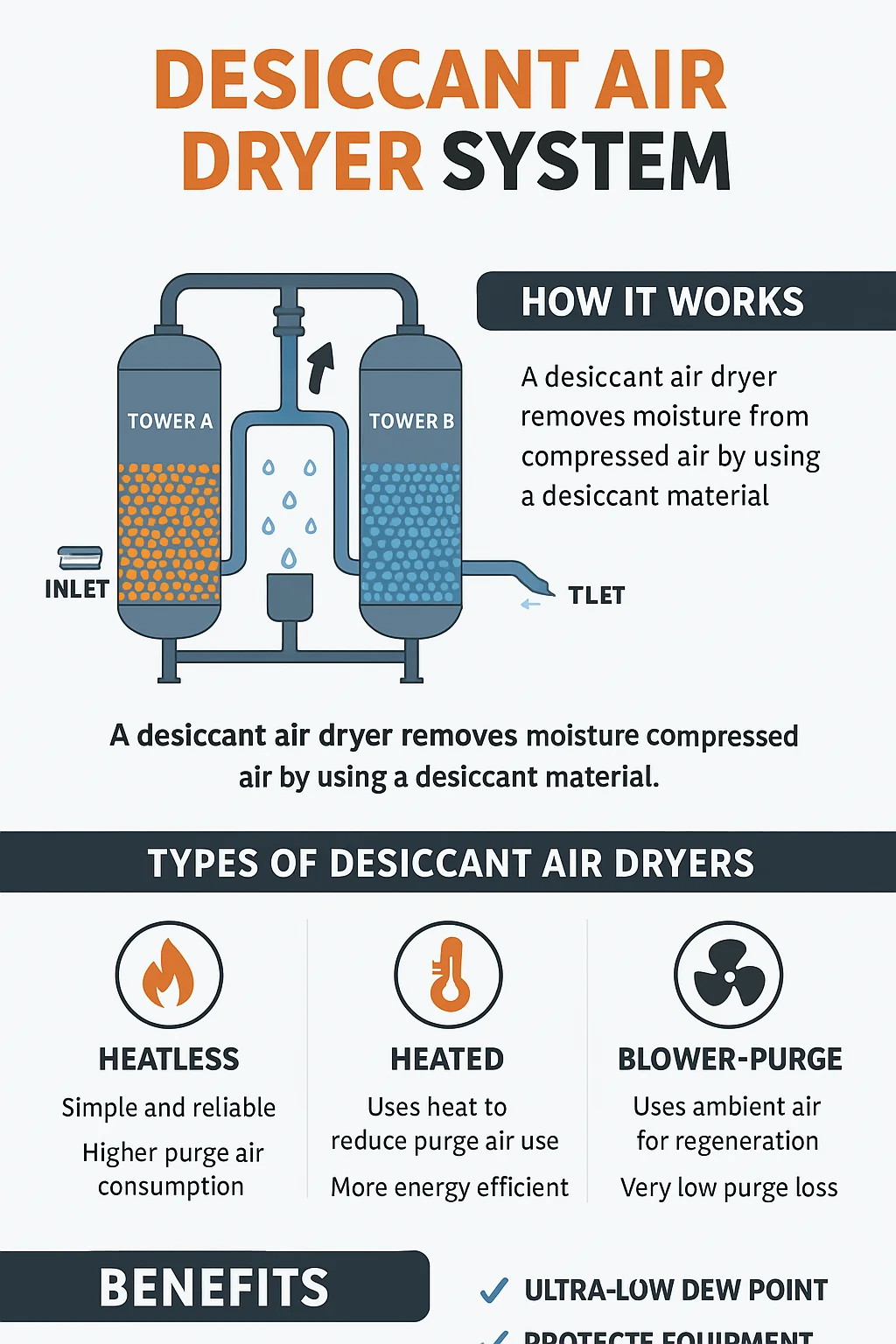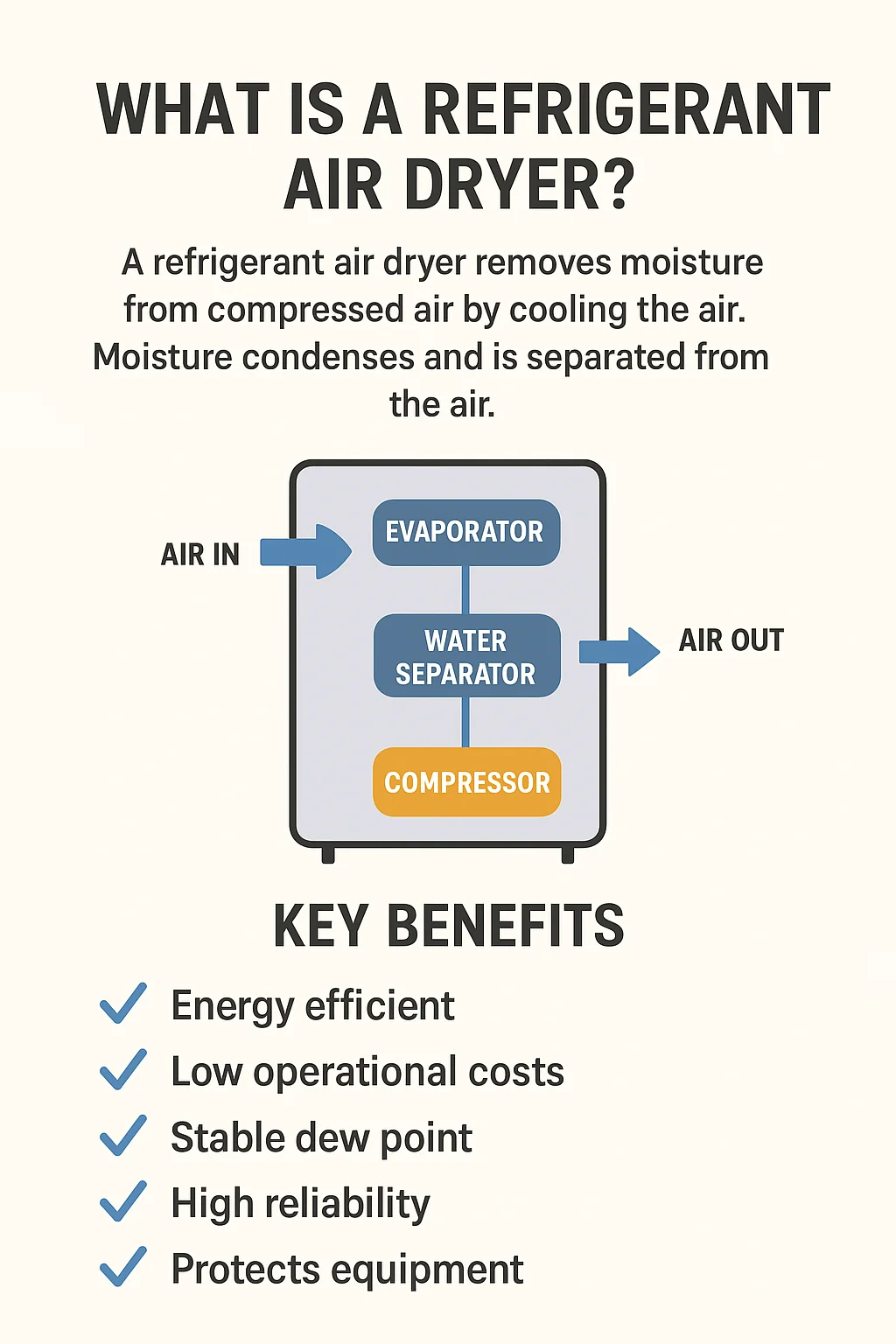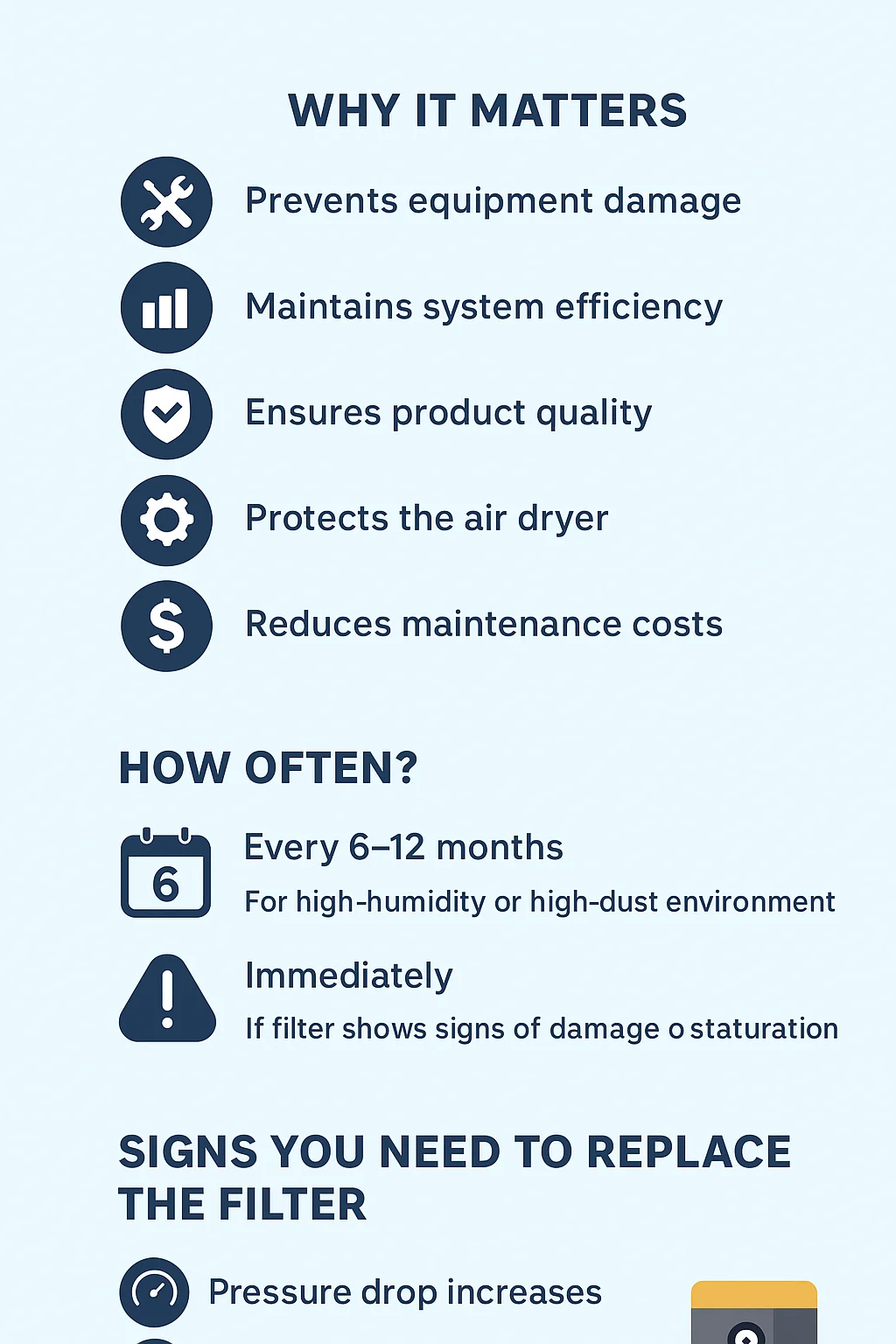An air dryer for compressed air is an essential component of any compressed air system. Its primary function is to remove moisture from compressed air — a crucial step in preventing issues such as rust, corrosion, and contamination. By delivering clean and dry compressed air, air dryers enhance the reliability, efficiency, and longevity of pneumatic equipment in both industrial and commercial applications.
This guide explores the different types of air dryers for compressed air, how they work, their key benefits, and expert tips on choosing the right system for your operation.
Why an Air Dryer for Compressed Air is Essential
Compressed air inherently contains water vapor. When air is compressed under high pressure, moisture condenses and accumulates within the system. Without proper drying, this moisture can cause several serious problems, including:
Corrosion and Rust – Moisture corrodes pipelines, valves, and pneumatic components.
Energy Inefficiency – Water buildup increases pressure drop and energy consumption.
Product Contamination – In industries like food, pharmaceuticals, and electronics, moisture can compromise product quality.
Accelerated Equipment Wear – Excess moisture shortens equipment lifespan and raises maintenance costs.
An Air Dryer for Compressed Air prevents these issues by effectively removing water vapor, thus improving system performance and extending equipment service life.
How an Air Dryer for Compressed Air Works
Air dryers operate by cooling, filtering, or absorbing the moisture present in compressed air. There are several types of air dryers, each using a distinct method to achieve optimal drying performance.
1. Refrigerated Air Dryers
Refrigerated air dryers lower the air temperature to condense water vapor into liquid form, which is then separated and drained away.
Process Overview:
Compressed air passes through a heat exchanger for cooling.
Water vapor condenses as the temperature drops.
A separator removes the condensed water before the dry air exits the system.
Refrigerated air dryers are cost-effective, energy-efficient, and ideal for general industrial use.
Related products:
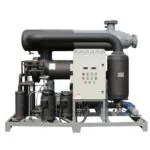
The 3885 CFM refrigerated air dryer (water cooled) is a high-capacity industrial solution designed for removing moisture from large-scale compressed air systems. Built for continuous and demanding operation, this water-cooled unit ensures a steady dew point and maximum system protection. Whether you're operating in petrochemical, steel, manufacturing, or pharmaceutical industries, the 3885 CFM refrigerated air dryer delivers superior drying performance and energy efficiency.
2. Desiccant Air Dryers
Desiccant air dryers use moisture-absorbing materials such as silica gel or activated alumina to remove water vapor from the compressed air stream.
Process Overview:
Compressed air flows through a desiccant bed that absorbs moisture.
Once saturated, the desiccant is regenerated using heat or dry purge air.
These dryers are perfect for applications requiring ultra-dry air, achieving dew points as low as -40°F.
Related products:
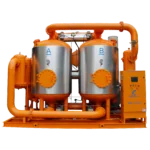
2. Customized high-performance adsorbent, 20% filling margin;
3. Branded high-pressure blower, high-performance pneumatic valve, high-efficiency cooler designed by HTFS software, reliable performance and long life;
3. Membrane Air Dryers
Membrane air dryers utilize semi-permeable membranes that selectively allow water vapor to pass through while retaining dry air.
They are compact, quiet, and do not require an external power source — ideal for small-scale or point-of-use applications.
Related products:
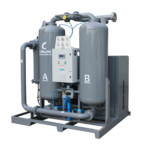
Integrated design: small footprint, easy to install, after years of technical research, modern technology and equipment production, each product is strictly tested to meet the use of standards before leaving the factory.
Benefits of Using an Air Dryer for Compressed Air
Implementing an Air Dryer for Compressed Air offers multiple operational and economic benefits:
Enhanced System Efficiency – Prevents pressure drop and energy loss caused by moisture accumulation.
Improved Product Quality – Ensures contamination-free production for sensitive industries.
Extended Equipment Lifespan – Protects pneumatic tools and machinery from corrosion and wear.
Reduced Maintenance and Downtime – Minimizes failures and costly repairs due to moisture damage.
How to Choose the Right Air Dryer for Compressed Air
Selecting the best Air Dryer for Compressed Air depends on your system’s specific requirements. Key factors to consider include:
Air Flow Rate (CFM): Match the air dryer’s capacity to your compressor’s maximum output.
Required Dew Point: Refrigerated dryers offer dew points of 35–40°F, while desiccant dryers reach much lower levels.
Operating Environment: Consider ambient temperature, humidity, and space constraints.
Energy Efficiency: Opt for models that minimize power consumption, especially for continuous operation.
Maintenance Needs: Refrigerated dryers require minimal maintenance, whereas desiccant dryers need periodic desiccant replacement.
Frequently Asked Questions (FAQ)
1. What is the main difference between refrigerated and desiccant air dryers?
Refrigerated dryers are suitable for general applications with moderate drying needs, while desiccant dryers provide extremely dry air for critical operations.
2. How can I determine the correct air dryer size for my system?
Match the air dryer’s flow capacity (CFM) to your compressor’s output and select the appropriate dew point based on your application requirements.
3. Can an air dryer eliminate all moisture-related problems?
A well-maintained air dryer minimizes moisture issues, but regular servicing and filter cleaning are essential for consistent performance.
4. How often should an air dryer be serviced?
Service intervals depend on the dryer type and usage level, typically every 6–12 months.
5. Are membrane air dryers energy-efficient?
Yes, membrane dryers are highly efficient and ideal for low-flow or decentralized systems since they operate without external power.
Conclusion: Maximizing System Reliability with the Right Air Dryer
An Air Dryer for Compressed Air is indispensable for maintaining efficiency, safety, and reliability in compressed air systems. Whether your facility requires a basic refrigerated model or an advanced desiccant system, choosing the right air dryer can reduce energy costs, prevent corrosion, and enhance product quality.
By understanding the functions and applications of different air dryer technologies, you can make an informed choice that protects your equipment, improves operational performance, and ensures consistent air quality.


